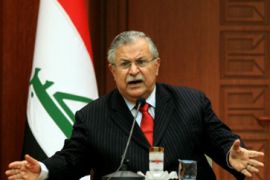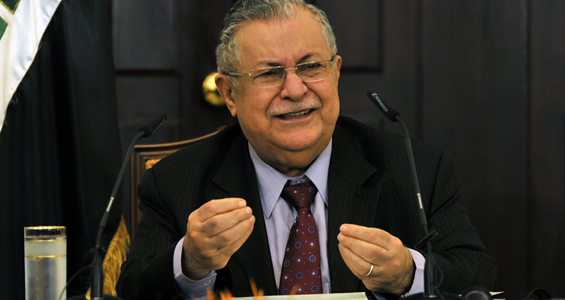Profile: Jalal Talabani
Kurdish leader opposed the Baathists for decades before becoming Iraqi president.

 |
| Talabani, who suffers from a heart ailment, says he will not seek re-election as president [EPA] |
The first Kurd to serve as Iraq’s president, Jalal Talabani is the leader of the Patriotic Union of Kurdistan (PUK), one of the two main Kurdish groups that dominate Iraq’s northern Kurdish region.
Born in 1933 in the village of Kelkan, Talabani was elected Iraq’s president on April 6, 2005. He has used his position to broker peace between ethnic and religious blocs within the government.
Talabani is one of the longest serving figures in contemporary Iraqi Kurdish politics, but for much of the past 40 years he opposed successive governments in Baghdad.
Among Kurds he is widely referred to as mam (uncle) Jalal.
Military leader
Talabani entered politics as a teenager, joining the Kurdish Democratic Party (KDP).
In 1956, as a law graduate of Baghdad University, he went into hiding to evade arrest for his political role as founder and secretary-general of the Kurdistan Student Union.
After graduating from law school in 1959, he was called to serve in the Iraqi army where he commanded a tank unit.
When the Kurds sought independence and rose against the Iraqi government in 1961, Talabani led battles at home in Iraq, as well as diplomatic missions to Europe and elsewhere in the Middle East to drum up support for his people.
The Kurdish revolt collapsed in 1975 and Talabani split from the KDP to form the PUK in an attempt to redefine the Kurdish political movement.
Today the PUK, which Talabani heads, controls the eastern part of Iraq’s Kurdish areas and has a militia of around 25,000 fighters.
The movement suffered badly when the Iraqi government under Saddam Hussein, then the Iraqi president, was reported to have used chemical weapons against the Kurds in 1988.
Talabani fled northern Iraq to seek asylum in Iran, from where he continued to lead armed resistance against Saddam.
Talabani’s political career took a fresh turn after the 1991 Gulf War and the subsequent Kurdish uprising against the Iraqi government.
Kurdish alliance
The establishment of a “no-fly” zone and a safe haven for Kurds above the 36th parallel by Britain, France and the US after Iraq’s defeat in Kuwait, marked the beginning of a short-lived honeymoon with the KDP.
Elections were held in Iraqi Kurdistan and a PUK-KDP joint administration was established in 1992.
But the underlying tension between the two parties pilled over into armed confrontation, dubbed the fratricide war, in 1994. Shortly thereafter, the KDP called on Saddam’s forces to help in routing the PUK. Talabani again fled to Iran.
However, their four-year conflict ended in 1998 with Talabani and Massoud Barzani, the KDP leader, signing a peace agreement in Washington after concerted efforts by the US and, to a lesser extent, Britain to defuse tensions between them.
The peace accord was further strengthened on October 4, 2002 when the regional parliament reconvened in a session attended by both parties’ MPs.
In that session, Talabani proposed that the parliament should pass a law prohibiting and criminalising inter-Kurdish fighting.
Talabani suffers from a heart ailment and has said he will step down from his post as Iraqi president when his term ends, likely to be in spring 2010.
However, he has said he will continue to be active in the PUK.